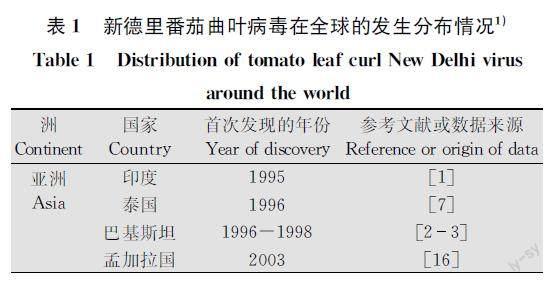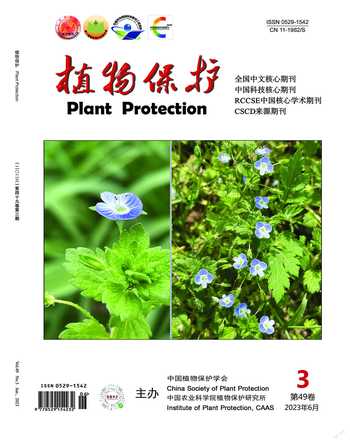警惕新德里番茄曲叶病毒在我国的传播和危害
杨秀玲 王亚琴 梅玉振 黄宏坤 王晓亮 刘万学 张辉 周雪平



摘要
新德里番茄曲葉病毒(tomato leaf curl New Delhi virus, ToLCNDV)是双生病毒科菜豆金色花叶病毒属病毒,由烟粉虱Bemisia tabaci以循环持久性方式传播,能对茄科和葫芦科等多种作物造成毁灭性的危害。近年来,ToLCNDV不断扩散蔓延至新的国家和地区。我国于2021年在浙江的温室番茄上发现了ToLCNDV的危害。本文综述了ToLCNDV的发生分布、基因组结构与进化、传播方式和寄主范围,提出了防范ToLCNDV在我国进一步传播和危害的防控建议。
关键词
新德里番茄曲叶病毒; 分布; 基因组结构; 传播方式; 寄主范围; 防控措施
中图分类号:
S 436.412.1
文献标识码: A
DOI: 10.16688/j.zwbh.2022788
Alert for the spread and damage of tomato leaf curl New Delhi virus in China
YANG Xiuling1, WANG Yaqin2, MEI Yuzhen2, HUANG Hongkun3, WANG Xiaoliang4,LIU Wanxue1, ZHANG Hui5*, ZHOU Xueping1,2*
(1. State Key Laboratory for Biology of Plant Diseases and Insect Pests, Key Laboratory of Surveillance and Management
for Plant Quarantine Pests of Ministry of Agriculture and Rural Affairs, Institute of Plant Protection, Chinese Academy of
Agricultural Sciences, Beijing 100193, China; 2. Institute of Biotechnology, Zhejiang University, Hangzhou 310058,
China; 3. Rural Energy and Environment Agency, Ministry of Agriculture and Rural Affairs, Beijing 100125, China;
4. National AgroTech Extension and Service Center, Beijing 100125, China; 5. Horticulture Research Institute,
Shanghai Academy of Agriculture Sciences, Shanghai 201403, China)
Abstract
Tomato leaf curl New Delhi virus (ToLCNDV), belonging to the genus Begomovirus of the family Geminiviridae, has been causing devastating damage to many crops such as solanaceous and cucurbitaceous crops. It is transmitted by Bemisia tabaci in a circulative and persistent manner. In the past few years, ToLCNDV has been spreading to new countries and geographic regions. ToLCNDV was reported to infect greenhouse tomato plants in Zhejiang province of China in 2021. In this review, we provide a profile of the distribution, genome organization and phylogenetic evolution, transmission, and host range of ToLCNDV. We also propose management strategies for the control of ToLCNDV to prevent the spread of ToLCNDV in China.
Key words
tomato leaf curl New Delhi virus; distribution; genome organization; transmission; host range; management strategies
新德里番茄曲叶病毒(tomato leaf curl New Delhi virus, ToLCNDV)是一种对番茄Solanum lycopersicum等作物造成毁灭性危害的双生病毒。该病毒最早于1995年在印度发现[1],而后迅速蔓延至印度的大多数地区以及巴基斯坦、孟加拉国、泰国等亚洲国家。2012年以来,ToLCNDV向西传播扩散至伊朗和西班牙等国,对黄瓜Cucumis sativus、西葫芦Cucurbita pepo和西瓜Citrullus lanatus等葫芦科作物造成严重危害,被欧洲和地中海植物保护组织(European and Mediterranean Plant Protection Organization,EPPO)列入警戒名单[24]。2021年Li等在我国浙江的温室番茄上发现了ToLCNDV的危害[5]。鉴于ToLCNDV的媒介昆虫烟粉虱Bemisia tabaci 在我国广泛发生[6],需高度警惕该病毒在我国的发生与蔓延。本文综述了ToLCNDV的发生分布、基因组结构与进化关系、传播方式和危害特征等内容,并提出了防范ToLCNDV在我国进一步传播和危害的建议。
1 ToLCNDV的发生分布
ToLCNDV最早于1995年在印度被报道危害番茄[1]。1996年-1998年,研究者们发现除了番茄外,ToLCNDV还危害泰国的甜瓜Cucumis melo、黄瓜、葫芦Lagenaria siceraria和絲瓜Luffa aegyptiaca以及巴基斯坦的龙葵Solanum nigrum[4,7]。与此同时,ToLCNDV扩散到印度各个地区,寄主范围不断扩大[89]。随后,该病毒被报道在印度和巴基斯坦危害胡萝卜Daucus carota var. sativa和苦瓜Momordica charantia等作物[3,1011]。2012年-2013年,ToLCNDV被证实与西班牙葫芦曲叶病相关[12]。2013年-2015年,巴基斯坦报道了ToLCNDV与棉花曲叶病的发生相关[13]。随后,ToLCNDV被报道在突尼斯的黄瓜、甜瓜和西葫芦以及意大利的西葫芦上引起了严重的危害[1415]。2021年,我国浙江约0.5 hm2的温室番茄出现叶片卷曲的症状,经高通量测序和分子生物学鉴定,发现引起该病害的病原是ToLCNDV[5]。
根据EPPO的最新数据,ToLCNDV已经在亚洲、非洲、欧洲和地中海地区的19个国家被发现并报道[13,5,7,12,1424] (表1)。
1) NA:没有相关数据;统计数据来源于已发表的文献以及欧洲和地中海植物保护组织(EPPO)网站(https:∥gd.eppo.int/taxon/TOLCND/distribution)。
NA:No data available. Data are derived from published references and the European and Mediterranean Plant Protection Organization (EPPO) Global Database (https:∥gd.eppo.int/taxon/TOLCND/distribution).
2 ToLCNDV的基因组结构与系统进化关系
ToLCNDV是一种双组分的菜豆金色花叶病毒属病毒,基因组为单链环状DNA,包含两个大小均约为2.7 kb的DNAA和DNAB组分(图1)。DNAA组分含有6个ORF,分别为病毒链的AV1和AV2以及互补链的AC1、AC2、AC3和AC4。AV1编码病毒的外壳蛋白,AV2可能作为RNA沉默抑制子抑制RNA沉默介导的防御反应,AC1编码病毒复制相关蛋白,AC2编码转录激活蛋白,AC3编码复制增强蛋白,AC4是症状决定因子和RNA沉默抑制子。DNAB组分含有2个ORF,即病毒链的BV1和互补链的BC1,分别编码病毒的核穿梭蛋白和运动蛋白。DNAA和DNAB的病毒链和互补链由共同区(common region, CR)隔开,CR包含病毒复制所需的茎环结构和9碱基保守序列(TAATATT↓AC)。与大多数的双生病毒相似,ToLCNDV编码的大多数蛋白具有多功能的特性,通过利用寄主因子完成复制、转录、运动等生活史或通过不同方式逃脱植物的抗病毒防御反应而促进病毒侵染[2528]。
图1 新德里番茄曲叶病毒(ToLCNDV)的基因组结构
Fig.1 Genomic organization of tomato leaf curl New Delhi virus (ToLCNDV)
对ToLCNDV DNAA的全长序列进行分析,发现ToLCNDV的序列具有较高的遗传多样性。根据国际病毒分类委员会的分类建议[29],现有的ToLCNDV至少可以分为7个不同的株系。大多数来源于亚洲的ToLCNDV分离物聚为一类,相似性在94%以上;来源于地中海地区的ToLCNDV分离物聚为一类,序列相似性在99%以上,但是与目前报道的其他ToLCNDV分离物相比,序列相似性在94%以下,被认为是ToLCNDV新株系,命名为ToLCNDVES。此外,一部分来源于印度和巴基斯坦的ToLCNDV分离物聚为另外一类[34]。重组是驱动双生病毒进化的重要因素,分析发现ToLCNDV的不同株系是由ToLCNDV与别的病毒重组产生的[3]。
3 ToLCNDV的传播方式
ToLCNDV在自然条件下由烟粉虱以循环持久性方式传播,即烟粉虱取食带毒植株后病毒随唾液进入到肠道,渗透过肠壁进入血淋巴,最后循环回到唾液腺,再取食其他植物时病毒随唾液进入植物体内。虽然ToLCNDV不能在煙粉虱体内增殖,但是烟粉虱一旦获毒可终身带毒并传毒。病毒除随烟粉虱传播,也可通过寄主和非寄主植物以及切花和新鲜草药等材料,经国际贸易远距离传播。与其他双生病毒相比,ToLCNDV与烟粉虱互作方面的研究报道还比较少。另有报道表明,感染ToLCNDV的西葫芦可以通过带毒种子传播[3031],但也有研究发现感染ToLCNDV的甜瓜种子可带毒,但是不传播病毒[32]。
4 ToLCNDV的危害特征
ToLCNDV寄主范围很广,可侵染茄科Solanaceae、葫芦科Cucurbitaceae、番木瓜科Caricaceae、豆科Fabaceae、锦葵科Malvaceae和罂粟科Papaveraceae等17科55种作物、花卉和杂草[2],常见的寄主有番茄、西葫芦、黄瓜、西瓜等茄科和葫芦科植物 (表2)。ToLCNDV危害番茄主要引起叶片卷曲、皱缩、脉明和黄斑驳等症状,在侵染后期引起节间缩短,影响坐果和产量(图2a);危害南瓜等葫芦科作物引起叶片卷曲、矮缩等症状(图2b)。ToLCNDV的不同分离物对不同寄主植物的适应性以及所导致的症状可能不同[34]。例如,ToLCNDV印度分离物在番茄上具有很强的适应性并诱导番茄植株产生明显的症状,但是来源于地中海地区的ToLCNDVES株系主要危害葫芦科作物,而对番茄的侵染性很低[12,33]。在自然界中,ToLCNDV可与双生病毒卫星DNA如alpha卫星和beta卫星相结合。Alpha卫星和beta卫星大小均约1.3 kb。Beta卫星是很多单组分双生病毒诱导寄主产生症状所必需的,其互补链上编码的βC1蛋白可通过不同作用方式从DNA水平、RNA水平到蛋白质水平破坏寄主的抗病毒防御反应而促进病毒侵染[34]。模拟接种试验发现,beta卫星加重ToLCNDV侵染后寄主的症状并且扩大ToLCNDV的寄主范围[3537]。ToLCNDV还与其他双生病毒如番茄黄曲叶病毒(tomato yellow leaf curl virus, TYLCV)、泽兰黄脉花叶病毒(bhendi yellow vein mosaic virus)、棉花曲叶病毒(cotton leaf curl virus)等病毒复合侵染,引起更加严重的症状或者产生新的致病类型[13, 34, 3841]。
5 监测与防控
ToLCNDV在印度发现并对印度番茄具有极大的破坏性。近年来该病毒已经传播扩散至不同的国家和地区,对茄科和葫芦科等作物的生产造成了严重影响。与ToLCNDV相似的番茄黄曲叶病毒(TYLCV)也属于双生病毒科菜豆金色花叶病毒属,可由烟粉虱传播。TYLCV自2006年首次入侵我国以来,已在我国24个省、直辖市、自治区危害番茄、辣椒和烟草等25种植物,造成巨大损失[42]。鉴于该类病毒的传播特性和烟粉虱在我国的广泛分布,且发生后基本无药剂可用的现状,需遵循“预防为主、综合防控”的植保方针[43],强化对ToLCNDV的检疫监测预警,明确ToLCNDV的侵染循环和流行规律,加强抗性品种选育研究,控制ToLCNDV在我国的传播和危害。
5.1 加强对ToLCNDV的检疫预警
鉴于该病毒威胁巨大,土耳其等国已通过WTO/SPS评议对进口的寄主植物种子提出了检疫要求(http:∥www.tbtsps.gov.cn/tbcx/getTbcxContent.action?mid=27178&TBType=5),预计还将有更多的国家将其列入检疫性有害生物管理。我国可根据目前ToLCNDV的发生和分布信息,开展风险分析,明确ToLCNDV在我国的适生区和潜在危害损失,评估将其作为我国进境和全国农业植物检疫性有害生物管理的必要性和可行性。
5.2 加强对ToLCNDV的监测与防控
开展普查和重点监测,明确ToLCNDV在我国的发生分布范围。强化对重点种子苗木基地的监测,开发快速检测试剂盒或者试纸条,在病害发生初期尽早和精准检测出病毒,提升末端早发现、早处置的能力。此外,轮作以及避开烟粉虱发生高峰期种植作物对于控制ToLCNDV的发生有一定效果。在没有烟粉虱或者在保护性设施中烟粉虱种群数量低的情况下,拔除感染病毒的植株。在发生区,可使用防虫网、黄色粘虫板等物理屏障驱避烟粉虱,并且结合生物防治和化学防治等有害生物综合治理策略来降低烟粉虱的种群数量,从而抑制病毒的传播[44]。
5.3 选育抗性品种
从长远来说,ToLCNDV抗性品种的培育是一项艰巨的工作,但却是控制ToLCNDV最经济有效的手段。近期研究发现,抗性基因Ty2和Ty3联合使用能够增强番茄对ToLCNDV的抗性[45],Sw5a能够提高番茄对ToLCNDV的抗性[4647]。下一步,需要对我国广泛种植的茄科和葫芦科作物的抗性进行评估,加强对ToLCNDV的致病机制和植物抗病毒机制的研究,挖掘针对ToLCNDV的抗性基因,为利用基因工程技术研发培育ToLCNDV的抗性品种提供靶标和策略。
參考文献
[1] MAHY B W J, VAN REGENMORTEL M H V. Encyclopedia of virology [M]. London: Elsevier, 2008: 124133.
[2] EPPO: Tomato leaf curl New Delhi virus. EPPO datasheets on pests recommended for regulation [EB/OL].[20221015]. https:∥gdeppoint 2022.
[3] MORIONES E, PRAVEEN S, CHAKRABORTY S. Tomato leaf curl New Delhi virus: an emerging virus complex threatening vegetable and fiber crops [J/OL]. Viruses, 2017, 9(10): 264. DOI: 10.3390/v9100264.
[4] ZAIDI S S, MARTIN D P, AMIN I, et al. Tomato leaf curl New Delhi virus: a widespread bipartite begomovirus in the territory of monopartite begomoviruses [J]. Molecular Plant Pathology, 2017, 18(7): 901911.
[5] LI Ruichen, LIU Yi, YIN Chuanlin, et al. Occurrence of tomato leaf curl New Delhi virus in tomato (Lycopersicon esculentum) in China [J/OL]. Plant Disease, 2022. DOI: 10.1094/PDIS06221427PDN.
[6] GUO Chenliang, ZHU Yongzhe, ZHANG Youjun, et al. Invasion biology and management of sweetpotato whitefly (Hemiptera: Aleyrodidae) in China [J]. Journal of Integrated Pest Management, 2021, 12(1): 116.
[7] ITO T, SHARMA P, KITTIPAKORN K, et al. Complete nucleotide sequence of a new isolate of tomato leaf curl New Delhi virus infecting cucumber, bottle gourd and muskmelon in Thailand [J]. Archives of Virology, 2008, 153(3): 611613.
[8] KUMAR R V, SINGH A K, SINGH A K, et al. Complexity of begomovirus and betasatellite populations associated with chilli leaf curl disease in India [J]. Journal of General Virology, 2015, 96(10): 31433158.
[9] PRATAP D, KASHIKAR A R, MUKHERJEE S K. Molecular characterization and infectivity of a tomato leaf curl New Delhi virus variant associated with newly emerging yellow mosaic disease of eggplant in India [J/OL]. Virology Journal, 2011, 8: 305. DOI: 10.1186/1743422X8305.
[10]SIVALINGAM P N, SUMIYA K V, MALATHI V G. Carrot as a new host for a begomovirus: yellow mosaic disease of carrot reported in India [J]. New Disease Reports, 2011, 23(1): 34.
[11]TAHIR M, HAIDER M S. First report of tomato leaf curl New Delhi virus infecting bitter gourd in Pakistan [J]. Plant Pathology, 2005, 54(6): 807.
[12]FORTES I M, SANCHEZCAMPOS S, FIALLOOLIV E, et al. A novel strain of tomato leaf curl New Delhi virus has spread to the Mediterranean Basin [J/OL]. Viruses, 2016, 8(11): 307. DOI: 10.3390/v8110307.
[13]ZAIDI S S, SHAFIQ M, AMIN I, et al. Frequent occurrence of tomato leaf curl New Delhi virus in cotton leaf curl disease affected cotton in Pakistan [J/OL]. PLoS ONE, 2016, 11(5): e0155520. DOI: 10.1371/journal.pone.0155520.
[14]MNARIHATTAB M, ZAMMOURI S, BELKADHI M S, et al. First report of tomato leaf curl New Delhi virus infecting cucurbits in Tunisia [J]. New Disease Reports, 2015, 31(1): 21.
[15]PANNO S, IACONO G, DAVINO M, et al. First report of tomato leaf curl New Delhi virus affecting zucchini squash in an important horticultural area of southern Italy [J]. New Disease Reports, 2016, 33(1): 6.
[16]MARUTHI M N, REKHA A R, CORK A, et al. First report of tomato leaf curl New Delhi virus infecting tomato in Bangladesh [J]. Plant Disease, 2005, 89(9): 1011.
[17]MIZUTANI T, DARYONO B S, IKEGAMI M, et al. First report of tomato leaf curl New Delhi virus infecting cucumber in central Java, Indonesia [J]. Plant Disease, 2011, 95(11): 1485.
[18]YAZDANIKHAMENEH S, GOLNARAGHI A R, RAKHSHANDEHROO F. Report of a new begomovirus on melon in Iran [J]. New Disease Reports, 2013, 28(1): 17.
[19]BANDARANAYAKE W, WICKRAMARACHCHI W, WICKRAMASINGHE H, et al. Molecular detection and characterization of begomoviruses associated with Cucurbitaceae vegetables in Sri Lanka [J]. Journal of the National Science Foundation of Sri Lanka, 2014, 42(3): 265271.
[20]RADOUANE N, TAHIRI A, EL GHADRAOUI L, et al. First report of tomato leaf curl New Delhi virus in Morocco [J]. New Disease Reports, 2018, 37(1): 2.
[21]SCUSSEL S, CLAVERIE S, HOAREAU M, et al. First report of tomato leaf curl New Delhi virus and the whitefly Bemisia tabaci Asia1 species on tomato in the Seychelles [J]. New Disease Reports, 2018, 38(1): 2.
[22]KHEIREDDINE A, SIFRES A, SEZ C, et al. First report of tomato leaf curl New Delhi virus infecting cucurbit plants in Algeria [J]. Plant Disease, 2019, 103(12): 3291.
[23]ORFANIDOU C G, MALANDRAKI I, BERIS D, et al. First report of tomato leaf curl New Delhi virus in zucchini crops in Greece [J]. Journal of Plant Pathology, 2019, 101(3): 799.
[24]DESBIEZ C, GENTIT P, COUSSEAUSUHARD P, et al. First report of tomato leaf curl New Delhi virus infecting courgette in France [J/OL]. New Disease Reports, 2021, 43(2): e12006. DOI: 10.1002/ndr2.12006.
[25]CHOWDHURY S, MUKHERJEE A, BASAK S, et al. Disruption of tomato TGS machinery by ToLCNDV causes reprogramming of vascular tissuespecific TORNADO1 gene expression [J/OL]. Planta, 2022, 256(4): 78. DOI: 10.1007/s00425022039851.
[26]PRASAD A, SHARMA N, CHIROM O, et al. The slymiR166SlyHB module acts as a susceptibility factor during ToLCNDV infection [J]. Theoretical and Applied Genetics, 2022, 135(1): 233242.
[27]VINUTHA T, VANCHINATHAN S, BANSAL N, et al. Tomato auxin biosynthesis/signaling is reprogrammed by the geminivirus to enhance its pathogenicity [J/OL]. Planta, 2020, 252(4): 51. DOI: 10.1007/s00425020034529.
[28]AGUILAR E, GARNELO G B, LOZANODURAN R. Recent advances on the plant manipulation by geminiviruses [J]. Current Opinion in Plant Biology, 2020, 56: 5664.
[29]FIALLOOLIV E, LETT J M, MARTIN D P, et al. ICTV virus taxonomy profile: Geminiviridae 2021 [J/OL]. Journal of General Virology, 2021, 102(12): 001696. DOI: 10.1099/jgv.0.001696.
[30]SANGEETHA B, MALATHI V G, ALICE D, et al. A distinct seedtransmissible strain of tomato leaf curl New Delhi virus infecting chayote in India [J]. Virus Research, 2018, 258: 8191.
[31]KIL E J, VO T T B, FADHILA C, et al. Seed transmission of tomato leaf curl New Delhi virus from zucchini squash in Italy [J/OL]. Plants, 2020, 9(5): 563. DOI: 10.3390/plants9050563.
[32]FORTES I, PREZPADILLA V, ROMERORODRGUEZ B, et al. The begomovirus tomato leaf curl New Delhi virus is seedborne but not seedtransmitted in melon [J]. Plant Disease, 2023. DOI: 10.1094/PDIS09211930RE.
[33]RUIZ L, SIMON A, VELASCO L, et al. Biological characterization of tomato leaf curl New Delhi virus from Spain [J]. Plant Pathology, 2017, 66(3): 376382.
[34]YANG Xiuling, GUO Wei, LI Fangfang, et al. Geminivirusassociated betasatellites: exploiting chinks in the antiviral arsenal of plants [J]. Trends in Plant Science, 2019, 24(6): 519529.
[35]VENKATARAVANAPPA V, REDDY C N L, SHANKARAPPA K S, et al. Association of tomato leaf curl New Delhi virus, betasatellite, and alphasatellite with mosaic disease of spine gourd (Momordica dioica Roxb. Willd) in India [J/OL]. Iranian Journal of Biotechnology, 2019, 17(1): e2134. DOI: 10.21859/ijb.2134.
[36]SIVALINGAM P N, VARMA A. Role of betasatellite in the pathogenesis of a bipartite begomovirus affecting tomato in India [J]. Archives of Virology, 2012, 157(6): 10811092.
[37]SHAHID M S, MANSOOR S, BROWN J K, et al. Interaction of a tomato leaf curl New Delhi virus with a betasatellite enhances symptom severity in fieldinfected tomato plants [J]. Tropical Plant Pathology, 2021, 46(2): 169174.
[38]VENKATARAVANAPPA V, LAKSHMINARAYANA R C N, JALALI S, et al. Association of tomato leaf curl New Delhi virus DNAB with bhendi yellow vein mosaic virus in okra showing yellow vein mosaic disease symptoms [J]. Acta Virologica, 2015, 59(2): 125139.
[39]SINGH A K, CHATTOPADHYAY B, CHAKRABORTY S. Biology and interactions of two distinct monopartite begomoviruses and betasatellites associated with radish leaf curl disease in India [J/OL]. Virology Journal, 2012, 9(1): 43. DOI: 10.1186/1743422X943.
[40]KANAKALA S, JYOTHSNA P, SHUKLA R, et al. Asymmetric synergism and heteroencapsidation between two bipartite begomoviruses, tomato leaf curl New Delhi virus and tomato leaf curl Palampur virus [J]. Virus Research, 2013, 174(1): 126136.
[41]CHAKRABORTY S, VANITHARANI R, CHATTOPADHYAY B, et al. Supervirulent pseudorecombination and asymmetric synergism between genomic components of two distinct species of begomovirus associated with severe tomato leaf curl disease in India [J]. Journal of General Virology, 2008, 89(3): 818828.
[42]LI Fangfang, QIAO Rui, YANG Xiuling, et al. Occurrence, distribution, and management of tomato yellow leaf curl virus in China [J/OL]. Phytopathology Research, 2022, 4(1): 28. DOI: 10.1186/s42483022001331.
[43]ROJAS M R, MACEDO M A, MALIANO M R, et al. World management of geminiviruses [J]. Annual Review of Phytopathology, 2018, 56: 637677.

